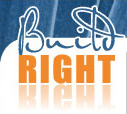Wind pressure
When wind flows around a building, it can produce some very high suction pressures. These occur mainly at the leading edges. In these areas, the cladding has to be firmly fixed to the structure and the roof has to be firmly held down. The flatter the roof, the higher the suction forces are on the roof and the more important it is to make sure that the holding-down straps are fixed securely into the structure.
Move your mouse over the different regions of the house to find out more information about the effects of wind pressure on a building.
Note: a pitchedA pitched roof has some slope or steepness. A roof with a steep pitch has a steeply sloping roof. roof with a slope that is less than 30o may have positive pressure or negative pressure (suction) depending on the wind direction and the slope of the roof.
Moving air affects a structure by exerting pressure on it. This pressure varies with the velocity of the air (speed and direction) and also with the shape and orientation of the structure. For example for one-storey or two-storey buildings in Sydney, the design wind velocity could vary between 30 m/s for a fairly well-protected site and 50 m/s for an exposed site. Melbourne experiences fewer storms than Sydney, so the design velocity could be as low as 25 m/s.
The selection of the correct wind load for a particular part of a building is both critical and complex. Compared with live loads, wind loads are considerable.
Factors affecting wind loads
